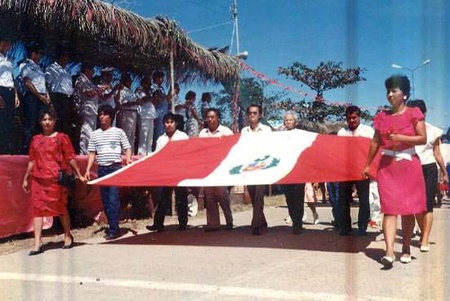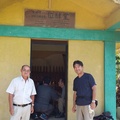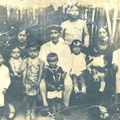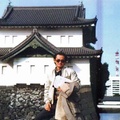Japanese immigration to Madre de Dios
Peru was one of the countries that received a large contingent of Japanese labor under the contract modality (1899-1923), as well as freely afterwards, by invitations from family members or by its own initiatives. Most of these Japanese immigrants were displaced to work on the sugar and cotton estates of the Peruvian coast and very few to the tropical jungle.
The descendants of these immigrants, currently up to the fifth generation, do not know or have a wrong idea of how and why their ancestors arrived to these tropical lands, so at this point in history, I consider it convenient that they at least have an idea of the how they arrived in these lands of the Peruvian Amazon and above all that it is known that we exist.
According to Isabelle Lausent, in her book "Presence of the Japanese in the Huanuco-Pucallpa axis" (page 5): "The Peruvian Amazon, like the coastal area, in the sugar and cotton estates, also demanded labor. Between the years 1905-1909, at the request of the Inca Rubber Company, the Morioka company and then the Meiji Colonization Company, they brought 500 Japanese in order to collect rubber from Tambopata; however, with the fall in the price of rubber and the subsequent bankruptcy of local farms, those Japanese workers were released from their contracts. A part dispersed to Brazil (Acre), others to Bolivia (Riberalta, Cobija). Another part remained in Madre de Dios, forming small agricultural colonies, as well as others formed by other nationalities. Their status as settlers was in this case completely accidental."
Other writers such as Hiroito Ota, in his analysis of the hundred years of history of the Buddhist mission in Peru, highlights that the Buddhist missionaries had intentions of installing a Buddhist church in the Tambopata area, since the North American company "Inca Rubber Corporation ", was building a bridle path between the Tirapata railway station in Puno to a navigable point on the Tambopata River (Astillero). Such information is corroborated by the NGOs ITTO (International Tropical Timber Organization) and AIDER (Association for Research and Development) when publishing their “Socioeconomic study of the native community of Infierno” (page 17), which "between 1902 and 1905, the rubber company Inca Rubber Company built a bridle path between Tirapata and Astillero and between the years 1908-1910 this company hired Japanese workers for these positions in the region", motivating the increase in traffic on the Tambopata River and the siege of the rubber tappers on the native population.
Similarly, Juan García Morcillo in “From rubber to gold-the colonizing process of Madre de Dios”, writes (p. 263) that "the efforts of the Inca Minig Company and the Inca Rubber Co., aimed at lowering The production costs of Peruvian rubber, diverting export to the southwest via Arequipa and the Port of Mollendo, were dedicated to the construction of a mule road between Astillero and Tirapata, in the jungle area of the department of Puno. For eight years ( 1902-1910), the work was prolonged and 500 Japanese were hired for the tasks of rubber exploitation and also for the cultivation of rice plantations and cattle raising. Although this road led to an important rubber area - in combination with the railroad - only a week away from Mollendo, the continuous depreciation of rubber made these companies abandon the project; however, the Japanese continued to arrive and gradually spread across the Tambopata, dedicating themselves to commerce and horticulture."
Downstream from the city of Puerto Maldonado, capital of the Madre de Dios department, is the Bolivian city of Riberalta, founded in 1894. On the portal “A window from Riberalta to the World”, it is noted that in this context, informed of the rubber boom, hundreds of Japanese boarded batelóns (rustic boats) in Puerto Maldonado and entered along the banks of the Madre de Dios River towards the communities of northern Bolivia, especially Beni and, according to data from the Federation of Bolivian Associations, Japanese (FENABOJA), the first group made up of 93 people, concluded their journey in Riberalta in 1920. In addition to working in the syringe, the first Japanese to settle in the La Gomera barracks worked as carpenters, bricklayers, hairdressers and farmers. In fact, the only transportation system used in the area was the river transportation through the Madre de Dios-Beni River, using steam boats to transport mainly rubber.
Reading an article by Enrique Higa Sakuda, about how we lack stories to tell, published by Discover Nikkei, he wondered: Of the thousands of Japanese who arrived in Peru, how many had kept diaries? Where are they? How many great stories would there be in them? Many times I also asked myself those questions until I dared to investigate and find part of that history but unfortunately, very little or almost nothing has been written about them, perhaps because Madre de Dios as a territorial or economically space means almost nothing. Today, after more than 100 years of political creation as a department, we as a region contribute barely 0.4% to the country's gross domestic product, that is, nothing. Under this scenario, could the Japanese farmer have developed as happened on the Peruvian coast or in the area of Santa Cruz-Bolivia or in Sao Paulo-Brazil? Really very difficult for multiple reasons, the main one being: the absence of economic infrastructure that would allow markets to be integrated.
Japanese surnames such as: Asakura, Horiuchi (Hori), Otzuka, Yamasaki, Yoshikawa, Nagarimori, Kameko, Mazuko, Koga, Ikeda, Takashima, Futakaki, Kaway, Isuyama, Fukumoto, Takahashi, Iguanaga, Okimura, Odagawa, Watanabe, Tamura, Nishizaka , Imura, Kano, Ioue, Noda, Osaki, Sato, Tabata, Miyashiro, Miura, Takashima, Nishida, Tanaka, Toyotomi, Nagay and many others, are worn today by their descendants, who form the Nikkei community of Madre de Dios that borders 2,500 inhabitants (the third nationally). Most Japanese, if not all, were forced to be baptized and acquire the Catholic religion as a requirement to integrate into local society and this seemingly simple act also generated the change of their original name.
The remains of those immigrants rest in the Pioneer Cemetery of Puerto Maldonado.
Family agriculture as a livelihood for the Nikkei community
Taking Madre de Dios as a destination at the beginning of the 20th century, I can't imagine what idea Japanese immigrants would have had before traveling to these areas at that time. Until 1980, Madre de Dios was an unknown territory, even for locals and strangers, simply because it was an isolated department in the national context, it did not have roads, air service or communications, with poor electrical energy, without basic services, it was for many considered a punishment zone. Let's imagine its situation at the beginning of the 20th century, a small populated center within a vast Amazonian plain.
The interest in these lands has been, is and will be the exploitation of their natural resources. In its beginnings (1890-1920) it was the extraction of rubber, in whose activity both national (mostly from the northern jungle, with experience in this type of activities) and foreign (Japanese with agricultural experience) labor was necessary.
With the debacle of the rubber boom and being freed from their contracts, the aforementioned Japanese bought land in the rural area and dedicated themselves to the cultivation of rice, vegetables, livestock, cassava, and banana; but, at the family level, without business ventures. Others dedicated themselves to commerce, carpentry, and fishing. With this group came a single professional, Dr. Hori to provide services to the community at large.
The agricultural sector in general, throughout the region has been and is subsistence, with little technology and the result is the low level of production and productivity which translates into a low level of income and, therefore, in a low level of life of the rural resident.
The Japanese introduced certain tools that farmers in the area use to this day, such as the mallet and the stick for peeling rice, the fan, the rice striper, the mill for grinding cane, growing tobacco and the manufacture of the tobacco mallet, the cultivation of rice, river transportation. In fishing, they introduced spinning rope for fishing. His contribution or contribution to the Madre de Dios was precisely those; The few pioneers or elderly settlers who still live remember with nostalgia that the Japanese supplied fresh vegetables to homes daily, but today 99.9% of those products come from other regions. Very few choose to live and work in the countryside, this being a national trend due to the lack of support from the State.
Higher education, as a fundamental pillar of development, was not possible in the Nikkei community, except for some of them; Therefore, until the 1990s, the Nikkei community was made up of low-income families, whose members had to supplement their income with various economic activities (agriculture, fishing, logging, chestnut extraction) to meet the costs. familiar costs.
The dekasegui phenomenon radically changed the economic and social situation of this community. The gloomy and discouraging past that existed in the environment was substantially improved by the Nikkei's remittances from abroad to their relatives, in such a way that today the Nikkei community - thanks to the efforts of its descendants - has substantially improved its standard of living.
THE ORGANIZATION IN THE NIKKEI COMMUNITY .
The Japanese immigrants were organized under the name of the Japanese Colony of Madre de Dios.
The Japanese colony, according to many, was a closed organization, exclusive for immigrants, perhaps due to the problems of racism and others that existed in society, in such a way that parents did not worry about teaching their children the language or The japanese culture. The Nikkei community only came into contact with Japanese culture when they traveled to Japan as dekaseguis.
The descendants of Japanese created their own organization, under the name of “Nisei Association” which later changed to “Peruvian Japanese Association of Madre de Dios”. The level of organization of this human group is very poor, despite the years that have passed, it has not been able to strengthen or consolidate. This is a pending issue that deserves special attention, given that the Nikkei identity is gradually being lost.
© 2015 Santos Ikeda Yoshikawa







